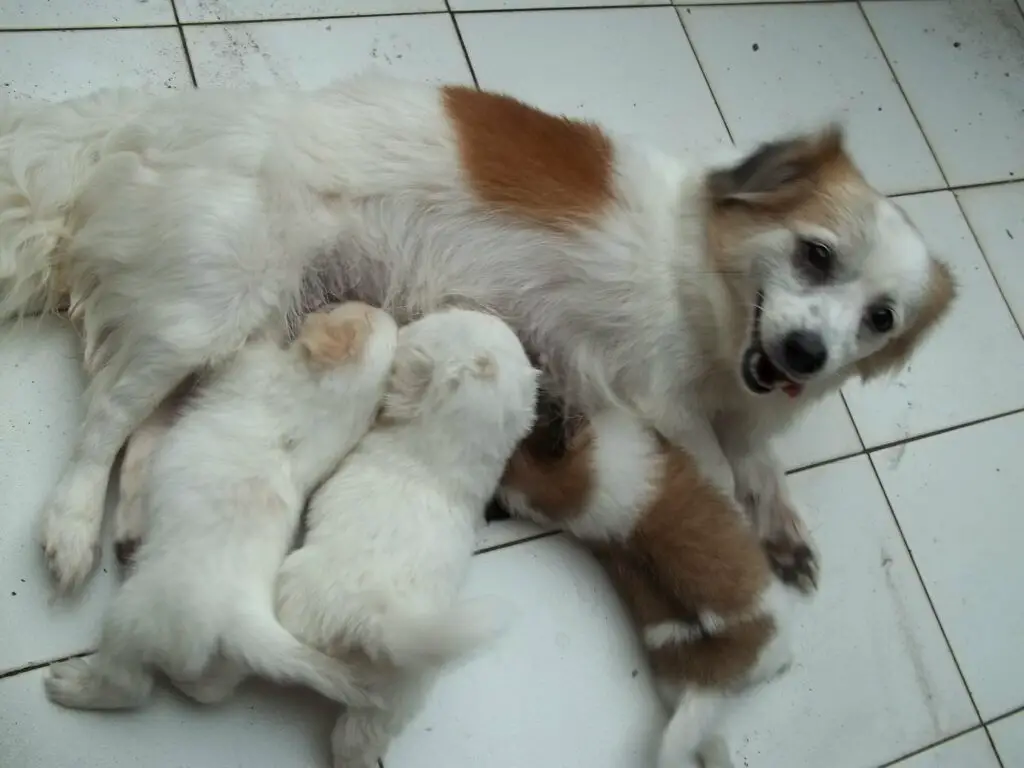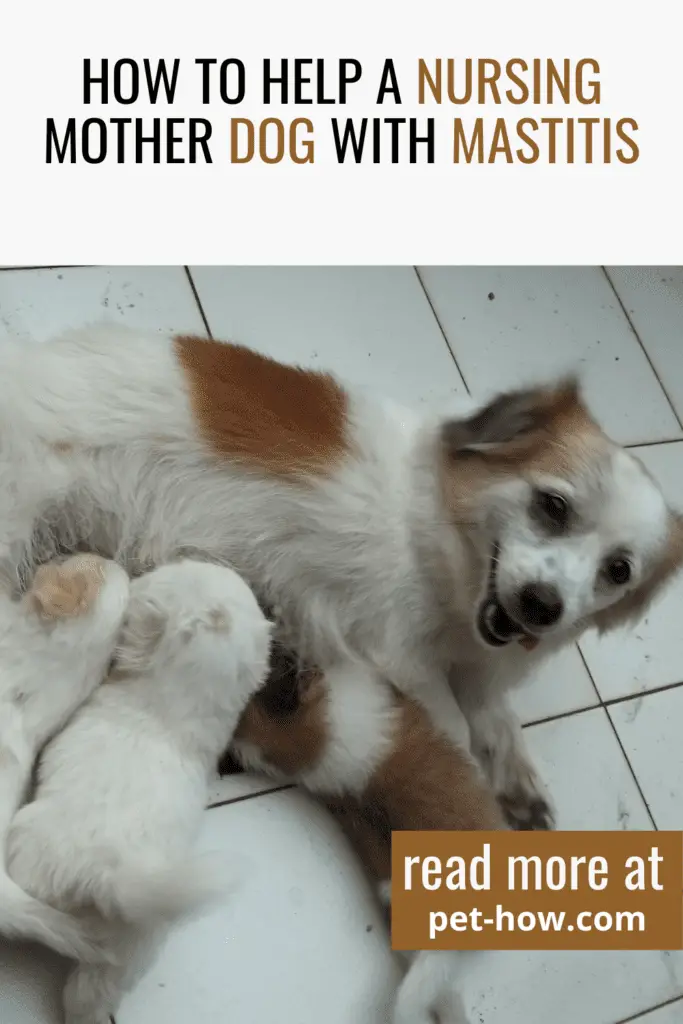If you have a litter of puppies in your home, first of all, congratulations. Your life is ten times happier.
However, with newborn puppies and nursing mothers, there are tons of things that can go wrong.
One of them is mastitis.
If the mother dog has mastitis, you need to know how to identify it, and what to do about it.
Read on to find out more about mastitis in dogs.
- What Is Mastitis in Dogs?
- How Do I Know If My Nursing Dog Has Mastitis?
- How To Help a Nursing Mother Dog With Mastitis
- What Can I Give My Nursing Dog For Mastitis?
- What To Do With Puppies If Mom Has Mastitis?
- Can Puppies Drink Milk If Their Mom Has Mastitis?
- Can Mastitis In Dogs Go Away On Its Own?
- How Long Does Mastitis Last In Dogs?
- In Conclusion
How To Help a Nursing Mother Dog With Mastitis
What Is Mastitis in Dogs?

Mastitis is a common infection of the mammary glands in female dogs, causing inflammation or swelling. It occurs when bacteria enter the mammary gland through small tears or breaks in the tissue.
The bacteria usually come from saliva, feces, urine, and other contaminated materials that come into contact with the nipples.
The primary cause of mastitis is improper hygiene during nursing. Nursing puppies can pull hard on their mother’s nipples, creating tiny tears which allow bacteria to enter.
Poor living conditions and lack of proper nutrition can also provide an environment for bacterial growth and increase the risk for mastitis.
Additionally, if not treated quickly, mastitis can become more serious and affect the entire mammary chain. This can lead to further medical problems.
Mastitis can also occur in dogs who are not nursing puppies, but this is much less common. Typically, the infection develops when bacteria enter through a wound or tear in the skin surrounding the mammary gland or from an abscessed area near the nipples.
Regular hygiene practices and cleaning of the nipples on a daily basis can help reduce the risk of mastitis.
Additionally, providing your dog with a nutritious diet and plenty of exercises may help keep her immune system strong and better equipped to fight bacteria that cause infections.
(See also: Why Is Milk Coming Out Of Puppy’s Nose When Nursing? (Answered!)
How Do I Know If My Nursing Dog Has Mastitis?
- Swelling or redness in the mammary area. This is one of the most common signs that your nursing dog has mastitis. The skin may appear hot to the touch and you may even be able to see pitting edema, which is a sign of inflammation.
- Pain: Your nursing dog will likely show signs of discomfort when her mammary area is touched or manipulated. She may also whimper or growl if she’s in pain due to mastitis.
- Change in milk production. A decrease in milk production can be another indication of mastitis in dogs. If it doesn’t seem to coincide with any other signs such as weaning puppies or the mother’s age.
- Painful nursing. Your dog may be reluctant to nurse her puppies if she has mastitis. She may even cry out in pain when one of them attempts to latch on.
- Discolored milk. Milky discharge from your nursing dog’s nipples that are greenish or yellowish in color is a sure sign of mastitis. Sometimes the milk can also have a foul odor associated with it as well.
- Lethargy and fever. If your nursing dog has developed an infection because of mastitis, she may seem generally unwell, act lethargic, and even run a fever due to her body fighting off the infection.
- Loss of appetite. If your nursing dog’s mastitis is severe enough, she may even lose her appetite. Go to the vet if she starts to refuse food and water.
- Abnormal discharge from the mammary area. Discharge that’s bloody, purulent (pus-like), or foul-smelling are all indications of more serious infection due to mastitis in dogs. This type of discharge needs immediate medical attention for your pet.
(See also: Fading Puppy Syndrome: Everything You Need To Know)
How To Help a Nursing Mother Dog With Mastitis
- Provide Comfort Care: Nursing mother dogs with mastitis need extra attention and care from their owners. Make sure she has access to comfortable rest areas, including warm bedding, and ample padding. Also, the mom needs enough space away from other animals. Additionally, try to reduce stress levels in any way possible since this can aggravate her symptoms.
- Monitor Milk Production: Mastitis inhibits milk production so it’s important to check for changes in your dog’s nipples or the appearance of her mammary glands on a regular basis. If her milk supply is reduced, you may need to supplement with additional food and fluids.
- Administer Antibiotics: Most cases of mastitis require antibiotics to fight the infection and help your dog get back to health as soon as possible. Make sure she gets the full course of treatment prescribed by the veterinarian– even if all symptoms disappear before that time.
- Clean and Disinfect: To avoid further infection or spread of bacteria, it’s important to keep your nursing mother dog’s mammary glands clean and free from dirt, debris, and other contaminants. Regularly disinfecting teats with a gentle soap can also be beneficial in preventing reoccurrences of mastitis.
What Can I Give My Nursing Dog For Mastitis?
Mastitis is a common condition in nursing dogs, but it is important to treat the infection quickly and effectively. If left untreated, mastitis can lead to serious complications such as pain, fever, and even sepsis.
If your dog has been diagnosed with mastitis, you should seek veterinary care right away. Your vet will likely prescribe medications such as antibiotics or antifungals to help clear up the infection.
Additionally, your vet may also recommend that your dog take probiotics or certain supplements to support her immune system.
In addition to prescribed medications from a veterinarian, there are some homemade cures that can help soothe symptoms associated with mastitis in nursing dogs.
One option is to give your dog onion juice. Simply puree an onion in a blender, and then apply the mixture to your dog’s nipples.
This will help reduce inflammation and pain associated with mastitis. Other homemade treatments include applying raw honey or turmeric paste to the affected area, as both of these ingredients have anti-inflammatory properties that can reduce swelling and discomfort.
Finally, make sure you are giving your nursing dog enough rest and hydration to support her while she is recovering from mastitis.
Providing a warm place for her to sleep and plenty of clean water will help keep her comfortable during this time.
How To Help a Nursing Mother Dog With Mastitis
What To Do With Puppies If Mom Has Mastitis?
- Determine if the Puppies Need Bottle Feeding: If their mother has mastitis and cannot produce enough milk, her puppies need supplemental bottle feeding to make sure they are getting adequate nutrition. Therefore, it is important to assess the situation and determine whether or not the puppies need a supplement to their mother’s milk.
- Have Your Veterinarian Examine the Mother and Puppies: After establishing that the puppies need supplemental feeding, you should bring both mother and puppies in for an examination with your veterinarian. The vet will be able to evaluate the severity of mastitis in the mother as well as confirm that all of the puppies are healthy and thriving.
- Find Nutritious Milk Replacers: Once the vet has cleared you to provide supplemental milk for the puppies, you’ll need to find a suitable milk replacer. Make sure it is nutritionally balanced and appropriate for the puppies’ age.
- Purchase Supplies To Bottle Feed Puppies: You will need bottles and nipples that are specifically made for puppies or kittens as well as other supplies such as formula scoops, bottle warmers, cleaning brushes, etc. These items can be purchased from your local pet store or ordered online if needed.
- Learn Proper Technique For Bottle Feeding Puppies: It is important that you learn how to properly bottle feed the puppies. That way they get enough nutrition without overfeeding or underfeeding them. You should consult with your veterinarian for help in learning the proper technique and follow their instructions closely.
- Make Sure Puppies Are Getting Enough Milk: Monitoring the puppies’ growth is key to making sure that they are getting enough milk from the bottle feedings and their mother’s milk. Regular weight checks, as well as frequent visits to the vet, can help ensure that their growth is on track.
- Provide Extra Care To The Mother: While you may be focused on providing supplemental feeding and care to the puppies, it is also important to monitor the mother’s condition and provide any extra care she needs. Talk to your veterinarian about ways to help her cope with mastitis while taking care of her puppies.
How To Help a Nursing Mother Dog With Mastitis
Can Puppies Drink Milk If Their Mom Has Mastitis?
No, puppies should not drink milk from their mother if she has mastitis. Mastitis is an inflammation of the mammary glands which can cause infection and be very painful for the mother.
The bacteria that cause mastitis can be passed to the puppies through her milk, potentially causing them to become ill.
It is best to seek veterinary advice if you suspect your female dog may have mastitis before allowing the puppies to nurse.
If it is determined that the mother does indeed have mastitis, they should provide suitable alternative sources of nutrition such as puppy formula or warm goat’s milk.
Puppies must receive adequate nutrition in order to grow and develop normally. So, it is important that any potential problems are addressed quickly and appropriately.
How To Help a Nursing Mother Dog With Mastitis
Can Mastitis In Dogs Go Away On Its Own?
In some cases, yes, mastitis in dogs can go away on its own. If your dog has a mild case of mastitis and it is caught early, the infection may resolve without requiring any treatment from your veterinarian.
However, if the infection persists or worsens, you should take your pet to a vet for antibiotics to help clear up the infection.
Additionally, a vet may suggest other treatments such as warm compresses or changing the position of feeding nipples if needed.
In cases where mastitis is severe or persistent, surgery may be required to remove damaged tissue.
For severe infections that cannot be cured with medical interventions alone, it may be best to have the affected mammary gland removed completely by your veterinarian.
Ultimately, the treatment of mastitis in dogs depends on the severity of the infection. It can range from keeping a close eye on your pet to more aggressive therapies.
How Long Does Mastitis Last In Dogs?
Mastitis in dogs can last anywhere from a few days to several weeks. The duration of the condition will depend on how quickly it is treated and whether or not any underlying conditions exist that may be contributing to mastitis.
If your dog has a bacterial infection, antibiotics are necessary and should begin working within a couple of days.
However, it could take up to two weeks for all symptoms to resolve. Additionally, if there is an underlying metabolic disorder or hormonal imbalance, it will need to be addressed in order to achieve full resolution of the mastitis.
It’s important that you closely monitor your dog during this time. Make sure they don’t become too uncomfortable or lethargic.
In Conclusion
Treating mastitis in dogs requires veterinary assistance.
The veterinarian will determine what kind of medication the dog may need to get.
In some cases, the vet might send you home with an ointment.






Leave a Reply